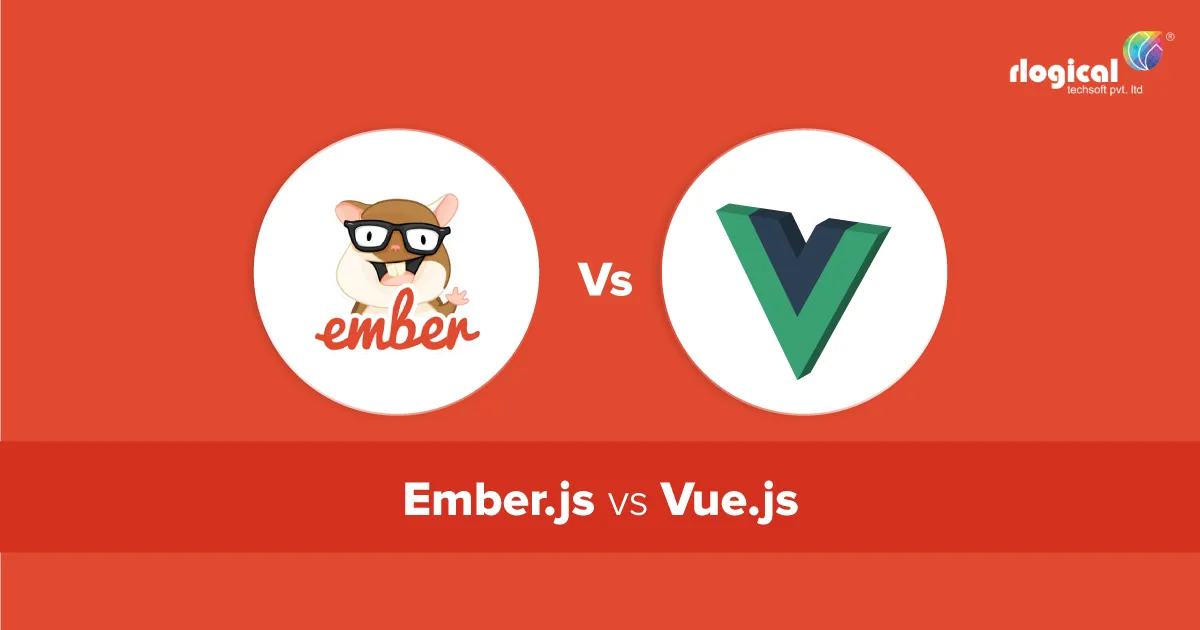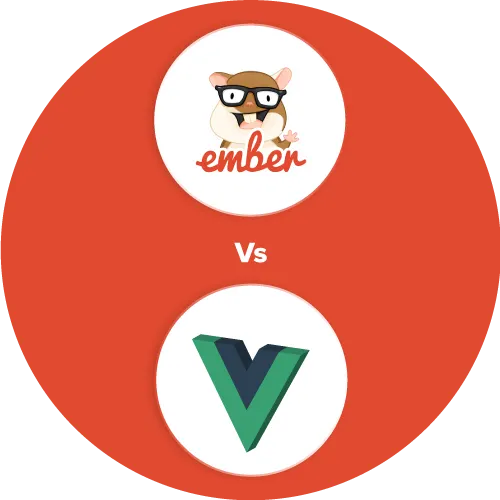
Vue is a sophisticated framework that promotes the progressive advancement of SPAs plus other application user interfaces proficiently. In contrast, Ember happens to be a contemporary framework intended for creating web applications with a rich user interface capable of functioning across any device. Both these frameworks offer adequate scalability in addition to future-proof opportunities; however, the question might arise in your mind regarding which one is the most effective for your web application development.
By the conclusion of this Vue versus Ember article, it will be possible for you to pick the appropriate front-end framework for your subsequent project, given that we are going to compare every single essential aspect of these frameworks in detail.
What is Ember JS?

Ember js is a front-end development framework that is JavaScript-based and extensively used for developing potential apps that need rich in-app interactions that incorporate complicated functionality. It is usually preferred for developing complex and customized Single Page Applications. Ember JS offers the facility of developing interactive apps without making the code appear messy whatsoever. It is likewise known for getting rid of boilerplate when coding and aids in writing programs without many iterations.
Well-known apps created with Ember:
Netflix
The batch request library of Ember has been used extensively for creating automated batches of file creation, upgrades, in addition to getting rid of unwanted information in bulk in simply one API call click.
Microsoft
The components of Ember effortlessly generate interactive visualizations, Power BI features, plus engage UI with user-friendly dashboards.
Enhanced searchability and content flow for Help center making use of Ember stack. The inbuilt product helps widgets that personalized users’ experience.
TED
Empowered developers to create open-sourced projects intended for TED. Additionally, DDAU architecture was used extensively for creating faster components rendering with legitimate DOM elements.
Also Read: Ember JS with its Pros and Cons
What exactly is Vue js?

Vue happens to be a sensible and lightweight JavaScript framework that is JavaScript-based and provides sophisticated web tools for creating modernistic front-end web apps and SPAs. It’s furthermore considered to be progressive and versatile given that it enables change creation in an app code without impacting the core features. This provides you with an opportunity to create a progressive user interface. Vue furthermore helps to extend the capabilities of a web app with customized modules, high decoupling, in addition to visual components.
Well-known apps created with Vue
Grammarly
Makes use of template engine syntax and data binding and creates the essential IDE features for developing an understandable and user-friendly online editor wrapped with a contextual layout and simplistic design.
Laravel Spark
Smooth operating of front-end app on the client-side. It provides total control over custom-built Vue components and SaaS applications for generating cumbersome features for Laravel Spark’s Primer client version.
Behance
Produced custom solutions that will be capable of uniformly tending to the app code plus standardized application with every single new visual feature added during the year. First and foremost, Behance implemented Vue for creating a roster shift between their programmers.
Must Read: Why is Vue.js Constantly Growing?
Pros of Ember JS
1. Sophisticated UI
Generate contemporary front-end applications with fewer query codes and semantic UI elements, including lightweight components for empowering developers and designers.
2. Quicker development
The time of development of large apps is significantly short with enhanced build time. It creates improved CSS visibility along with hassle-free source mapping of SCSS for minimizing parsing and code downloads.
3. Devoted community
A supporting community that dedicates constant repositories and resources for discussing innovative features, monitoring queries for instigating conversions, requesting community inputs, and enhancing the Ember ecosystem.
4. MVC and DDAU architecture
Ember employs two kinds of architectures nowadays. Previously, it implemented the MVC framework that granted automated updates of data within an app without external APIs and JSON requirements. These days, it employs the DDAU pattern for emphasizing the unidirectional flow of data.
5. Router feasibility
Gain access to and acquire the requested information by using Ember to pass the said information using a request. In addition to application templates, routing handlers are less complicated with Ember than other frameworks.
Cons of Ember JS
1. Code configuration
Not much room is provided by conventional code configuration for the personalization of backend APIs or pre-generated URLs. If you hire emberJS developers, it allows them to incorporate custom-made external elements or components only to a certain degree.
2. Rendering
Apps developed using Ember are known to render at a slower rate at the time of an application’s startup than the majority of the other frameworks. This leads to a lagged response even though the performance does pick up after a short delay.
3. Integration difficulty
Ember comes with the benefits of offering design choices; however, it’s likewise challenging to incorporate with other MVC frameworks. Ember makes it quite difficult to recognize elements that lie inside the app for shimming and testing at the time of integration.
4. API limitations
If a non-restful API is employed in an Ember app, the possibilities of data callback and performance issues using API come up. Even though Ember is known to work properly with a Rest adapter, it is not the same with non-restful APIs. Creating requests for pulling external or complicated links from the backend could be quite difficult using Ember.
Also Read: EmberJs Vs. ReactJs: Everything You Need to Know
Pros of Vue
1. Progressive
It is possible to gradually migrate or integrate Vue into the code while creating components without wasting any time for development.
2. Conventional
Vue helps to make writing boilerplate code simple by using in-built solutions for developing state support for handling animations and components. The traditional approach makes the entire process of development with Vue speedier.
3. Effective Size
With every single new Vue version that is released, the framework becomes faster and lighter. In case you hire Vue.JS developers, Vue’s optimization ability allows them to emphasize feature enhancements more than code tweaking or debugging.
4. Functional Extension
Vue provides a set of additional API features that happen to be function-based, which enable the composition of component logic to be extensive and flexible. Consequently, application components turn out to be more extendable and readable when it comes to functionality.
Cons of Vue
1. Community
Vue has got a community lacking in language understandability. With Vue being well-known in areas around China, most of the discussions happen to be in Chinese, thus making it quite challenging for developers who are English-speaking to learn the framework.
2. Code Reactivity
Vue’s two-way binding character is useful for creating and syncing components across an app. This leads to the rendering of information chunks brought on by the DOM.
3. Support
Vue is nevertheless considered to be a young platform. Its community is comparatively small, and therefore, programmers usually face challenges while handling issues arising for large-scale projects.
Also Read: Vue.js with Laravel to Build Robust Applications
Comparison between Vue JS and Ember.js
VueJS |
EmberJS |
| Quite Stable | Not Stable |
| Large Community | Smaller Community |
| Plenty of updated documentation and tutorials | Most of the tutorials are outdated |
| Lightweight and Ideal for smaller projects | Heavyweight and appropriate for complicated projects |
| Quite Simple to Learn | Difficult to Learn |
| Coding speed fast | Coding speed fast |
In this article, we will be comparing the features of both frameworks. It will guide you to take advantage of the appropriate framework for creating your web app.
When you require a contemporary engine for an outdated application, Vue.js will be coming to your rescue. It helps to combine the best attributes of the other frameworks. Vue.js happens to be a developing framework. You will not come across a ready-to-use collection of interface elements. Nonetheless, a lot of third-party libraries can come to your assistance.
Ember.js is known to provide you with a trustworthy and properly organized framework. This framework will be ideal for you in case the development team happens to be big. It enables everybody to comprehend the written code and also make contributions to a common assignment. The technology is going to be up-to-date, while the platform is going to be stable.
Vue.js can assist you in using different types of syntax. It aids in writing the codes effortlessly. It is likewise a framework that is SEO-friendly. Ember happens to be a front-end framework that is fully loaded and can assist you in developing the apps quite fast. However, it is not ideal for creating small projects.
It is not simple to declare this is better as compared to that. It is going to depend on what type of project has been undertaken by you. Both come with their positive as well as negative aspects.
1. Stability
While Vue JS is quite stable, the same cannot be said about Ember JS.
2. Community
Vue JS can boast of having a large community that Alibaba and Laravel back. On the other hand, the community of Ember JS happens to be smaller.
3. Documentation
When it comes to Vue JS, you will come across plenty of updated documentation and tutorials. However, In the case of ember JS, most of the tutorials are outdated.
4. Code Base
Vue JS is considered to be lightweight and ideal for smaller projects. On the contrary, ember JS happens to be heavyweight and appropriate for one page and complicated projects.
5. Simplicity of learning
It is quite simple to learn Vue JS. However, ember JS is somewhat difficult to learn.
6. Coding speed
Both these frameworks are quite fast when it comes to coding speed.
7. Reactivity
Vue JS is reactive on simple JavaScript objects as well as fully computed and automated properties. Everything needs to be wrapped in Ember objects. It is imperative to declare dependencies employing computed properties.
8. Performance
With the batches updated automatically, Vue JS outperforms Ember JS. In the case of Ember JS, it is imperative to manually manage run loops in vital performance situations.
9. Routing
Single-page applications can use the Vue router library. In ember JS, while using the router, it will be possible to drive the application state from the URL.
Conclusion
It is quite difficult to assert which is better, Vue JS or ember JS. It will depend on the app that you like to create. Both these frameworks are developing at present. Both of them are receiving updates. Both communities are working on them. While you might find Vue.js more comfortable when it comes to writing codes, Ember JS happens to be a full-stack framework enabling the development of applications quite fast. It is appropriate for large projects. It is overly complicated to be employed for small projects.
Jatin Panchal
Jatin Panchal is the Founder & Managing Director at Rlogical Techsoft Pvt. Ltd. For more than a decade, he has been fostering the organization's growth in the IT horizons. He has always bestowed personalized approaches on .NET, PHP, Flutter, and Full-Stack web development projects. From startups to large enterprises, he has empowered them to accomplish business goals. By delivering successful industry-driven solutions, he is encouraging the capability of AI, ML, blockchain, and IoT into custom websites and hybrid mobile applications.
Related Blog
- A Guide on Progressive Web App with React: The Long-Term Solution for Business Growth
- Top JavaScript Frameworks For Your Web Applications Project
- Why Use VueJS? Most Popular Frontend Framework for Your Web Development
- Create Appealing Real-Time Applications with NodeJS: The JavaScript Edge for Apps
- Top Apps Built With Node.js: The Success Story of NodeJS
Categories
- All
- AI Development Services
- Amazon Web Services (AWS)
- ASP.Net Development
- Azure Web App
- Big Data Analytic
- Customize
- Digital Marketing
- Drupal Development
- E-commerce web development
- Education Mobile App Development
- Enterprise Application
- Event Management App Development
- Fintech
- Fitness App Development
- Food Delievery
- Front-End Development
- Grocery App Development
- Healthcare App Development
- Hire Dedicated Developers
- Hotel Booking App
- IT Industry
- JavaScript Development
- Mobile App Development
- On Demand App Development
- On Demand Healthcare App Development
- PHP Development
- POS Software Development
- Real Estate Mobile App Development
- Retail Business App Development
- Salesforce
- Social Media Development
- Software Development
- Technology
- Transportation App Development
- UI/UX Design
- Web Design
- Web Development
- Web Services
- Web/Data Scraping Services
- WordPress




 Jatin Panchal in JavaScript Development
Jatin Panchal in JavaScript Development 





